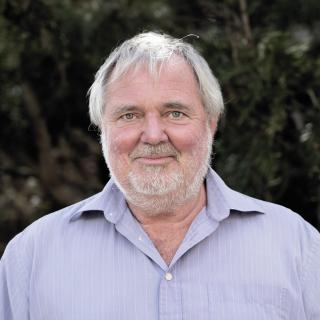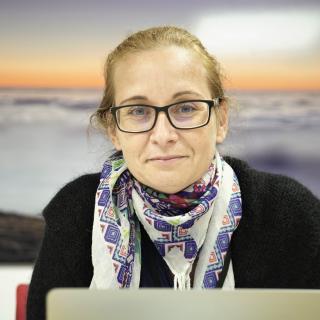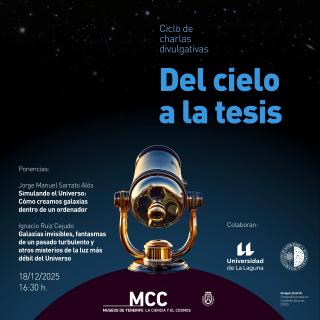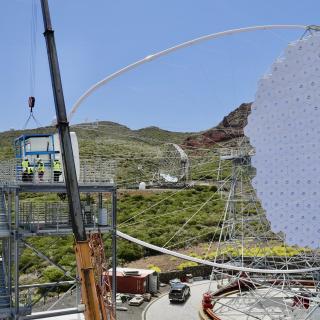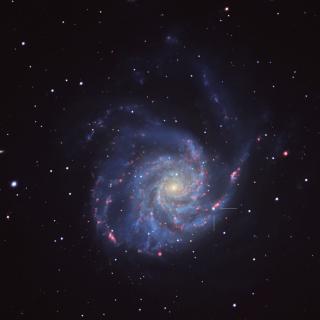The gravitational force needed for the universe to evolve from when it was almost uniform, during the Big Bang, until galaxies, stars, and planets were formed is provided by the “dark matter”. But in spite of the essential role of this basic component, which is estimated to make up some 80% of the matter in the universe, scientists know virtually nothing about its nature, behaviour, and composition, which is one of the main challenges in current physics and cosmology. Aiming to give answers to these questions the researcher Diego Blas, Senior Lecturer in the Department of Physics of King’s College, London has spent time in the IAC invited by the Jesus Serra Foundation Visitor Programme, which promotes visits to the IAC by researchers with international prestige.
Question: In which projects have you participated during your stay at the IAC?
Answer: During my stay at the IAC I collaborated with Jorge Martín Camalich on varius ideas. We have a project under way together with Ricardo Génova Santos and Jorge’s group to detect dark matter in the form of axions (a popular model) in the data from QUIJOTE (an experiment led by the IAC). We are also talking a lot to Nacho Trujillo and Jorge Sanchez about new ideas to characterize dark matter from data on galaxies. Also with Javier de Miguel about his idea of detecting axions in the DALI experiment. Finally I have very interesting conversations with othe rmembers of the group about the great opportunity the IAC is offering in fundamental physics. In fact a large fraction of my stay was devoted to thinking how to exploit different synergies between groups at the IAC and the most difficult problems in cosmology and particle physics; what is dark matter, and what lies beyond the standard model.
Q. What role can the IAC and the Canary Observatories play in these projects?
A. The IAC and the Canary Observatories have a great potential in these projects. Firstly there are scientists of high quality who are references in the world, in observations. Our idea is to capitalize this potential and also to convert it into projects which tackle aspects of the universe which are not usually questions that observational groups study. This opens a fascinating possibility of using the most up to date observations to study questions which we call fundamental (for example, what is the mechanism behind the present abundance of matter?). Secondly, being able to talk directly to those in charge of the telescopes makes us think of new strategies to optimize these searches directly in the observations. During my stay we had a very fruitful and exciting afternoon taling to the director of the IAC, Rafael Rebolo, which gave rise to many possibilities which could impact on new frontiers in the search for the basic constituents of the universe.
Q. What is the importance of institutions such as the Jesús Serra Foundation supporting this type of interchange?
A. Programmes such as that of thte Jesús Serra Foundation are of vital importance to promote dialogue between centres. My experience with other organizations such as CERN is that a well organized programme of visitors, where the people involved are free to interact with whom they please, is the bset way for raising new questions and opening new directions in research. It is essential to maintain a dialogue within centres of excellence such as the IAC, and ensure that the various groups include visitors who enlarge their fields of interest. The pandemic made this more difficult in some ways, but in general I think that the results have been very positive.
Q. What are the big questions about the universe which are most urgent and easiest to answer? How do you think that we can answer them in the next few years?
A. There are many questions about the universe which are fascinating, and to which the data which we will obtain in the next few years could resolve. One of the most urgent is to understand the nature of the “dark sector” which composes 96% of the energy distributed around the universe today, and which we cannot detect in our laboratories (only by its effect on the large gravitating structures in the universe). We will be able to detect it now that our level of control is close to the limits of science fiction? (For example, with atomic clocks whose precision is so high that two such clocks syncronised 10,000 million years ago would read differently now by at most one second). Or will we need new telescopes, increasinglhy large and powerful? Or perhaps with new signals such as the recently detected gravitational waves? What is clear is that we have entered a Golden age where the connection between theory and observation is more and more necessary in centres such as the IAC, to be able to squeeze all the juice form the data and design experiments which correspond to the most fascinating science.
Q. Why do you think that science, and especially physics, is important for society?
A. Science has made it possible for us to confront the biggest world crisis in history (not self-inflicted) and produce a vaccine in record time. We live longer and better than ever before in history, and all of that has much to do with the progress of science. Independently of that, I like to think that scientific activity is one of the most human of activities and that as such it is one of the most important. In five hundred years’ time almost nobody will know who played in this or that team, or who sold more or fewer actions, but scientiric advances certainly has a long term impact. Physics is one example to this. We live surrounded by the advances of physics in the XX century: the transistor, general relativity, quantum mechanics, give their products over a long time scale. Also physics is important to make our society dream of being proud of our understanding of nature, and of the common effort behind such existing advances.
Q. What support do you consider necessary for scientific research?
A. In the first place we need a stable plan for science (which does not depend on the colour of the government), and where scientists have a voice and power. Also put an end to precarious employment, above all during the early phase of stabilization (there are many very well qualified people who want to return to Spain but would have to make terrible sacrifices in their working conditions), We need to empower centres of excellence (such as the IAC), run by international committees who avoid nepotism. And of course there is a need to increas the budget. One of the main changes needed in Spain is that private companies need to commit to research. The “German” or “Swiss” model is excellent, the private companies fund much of the applied research which gives them profits in the long term, while the government funds more basic science with centres of excellence. In our country scientists are always considered very highly in any survey but then the governments do not react to this. We must also help that the figure of the scientist recovers status. In fact today there is a real brain drain of people who are moving into the field of Big Data to earn a decent salary. All of this is completely possible and realistic, things just have to move in the correct direction.
